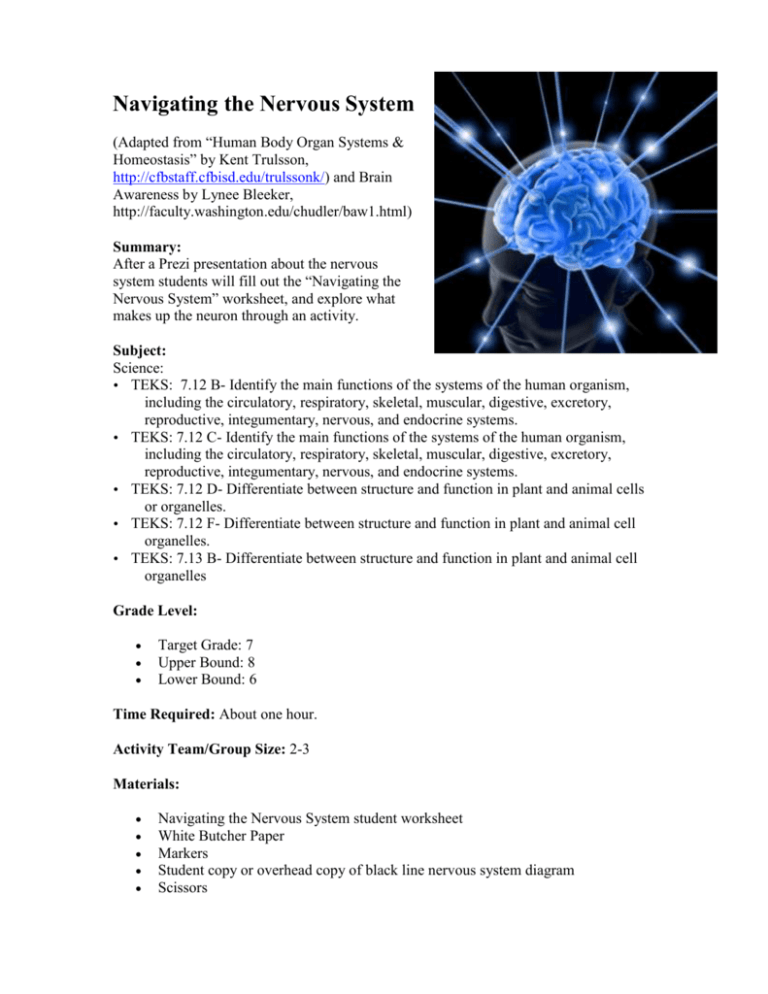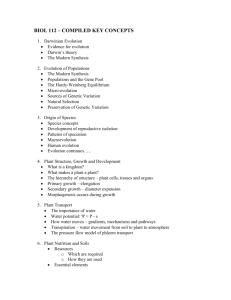Navigating the Nervous System
advertisement

Navigating the Nervous System (Adapted from “Human Body Organ Systems & Homeostasis” by Kent Trulsson, http://cfbstaff.cfbisd.edu/trulssonk/) and Brain Awareness by Lynee Bleeker, http://faculty.washington.edu/chudler/baw1.html) Summary: After a Prezi presentation about the nervous system students will fill out the “Navigating the Nervous System” worksheet, and explore what makes up the neuron through an activity. Subject: Science: TEKS: 7.12 B- Identify the main functions of the systems of the human organism, including the circulatory, respiratory, skeletal, muscular, digestive, excretory, reproductive, integumentary, nervous, and endocrine systems. TEKS: 7.12 C- Identify the main functions of the systems of the human organism, including the circulatory, respiratory, skeletal, muscular, digestive, excretory, reproductive, integumentary, nervous, and endocrine systems. TEKS: 7.12 D- Differentiate between structure and function in plant and animal cells or organelles. TEKS: 7.12 F- Differentiate between structure and function in plant and animal cell organelles. TEKS: 7.13 B- Differentiate between structure and function in plant and animal cell organelles Grade Level: Target Grade: 7 Upper Bound: 8 Lower Bound: 6 Time Required: About one hour. Activity Team/Group Size: 2-3 Materials: Navigating the Nervous System student worksheet White Butcher Paper Markers Student copy or overhead copy of black line nervous system diagram Scissors Pipe cleaners Reusable Activity Cost Per Group [in dollars]: $5 (markers and scissors) Expendable Activity Cost Per Group [in dollars]: $5 (white butcher paper, pipe cleaners, and handouts) Learning Objectives: In small groups students will be introduced to the nervous system. Students will learn the structure and function of the Central and Peripheral Nervous System. They will explore that a neuron is the nerve cell that makes up the nervous system, and learn what makes up the parts of the neuron. Lesson Introduction / Motivation: Ask students if they know anything about the nervous system. Do they know what their brain does to learn? Do they know what their spine does? Tell them that they can “trick” their brains due to how our eyes relay information. Show them the PowerPoint of brain “tricks” to spark their interest in the subject, and then begin with the lesson to explain why they were “tricked”. Lesson Plan: Present the Prezi Presentation: (https://prezi.com/secure/5f043335c9dbf23a6104ffc580b31f845c934a0e/). As students watch the presentation ask if they have questions, and have them fill out the Navigating the Nervous System worksheet. Get them to interact during the presentation by calling on students and allowing them to read the bullet points in the Prezi Presentation, play the video of the nerve impulse. After the Prezi Presentation arrange students in small groups of 2-3, give each group butcher paper and a marker. Have students trace an outline of one group member on the butcher paper, then draw and label the Central and Peripheral Nervous systems. Walk around to groups and point to a part of the Peripheral Nervous System, ask students what they think this nerve does. (Ex: Point to a nerve drawn in the hand, this would give sensory feeling and muscle function to the hand.) As groups finish drawing their nervous system, pass out pipe cleaners and a pair of scissors to each group. Instruct the class that they will now be constructing a neuron. Ask students to again define what a neuron is. On the overhead show the Prezi picture of the neuron during this entire part of the activity. Emphasize the nervous cells unique long and thin shape. Ask what the main job of the nerve cell is. (Answer: to send and receive messages quickly). Relate this to their world using the analogy of a phone line; we use phones to communicate across town and across the country. How? The long thin wires, much like the neuron. Emphasize that never cells do NOT touch; they have tiny gaps called “synapses” that use chemicals to transfer the message being sent from cell to cell. Now have students make their pipe cleaner neuron. With the following steps: 1. Take one pipe cleaner and roll it into a ball. This is will be the cell body. 2. Take another pipe cleaner and attach it to the new "cell body" by pushing it through the ball so there are two halves sticking out. Take the two halves and twist them together into a single extension. This will be the axon. 3. Take other pipe cleaners and push them through the "cell body" on the side opposite the axon. These are dendrites. These can be shorter than your axon and you can twist more pipe cleaners to make more dendrites. If there is time have students review what each part of their neuron does. Lesson Closure: Ask students to define the dendrite, and then explain that neuroscientists have learned dendrites sprout to make connections with other neurons. This is how learning takes place! This means that as long as you have neurons you can always continue learning, but in order for these connections to occur you must have new experiences. This can either be in the classroom, or through reading books! Thus school gives you new experiences so that connections can form in your brain! Assessment: Grade the students’ short answers on the worksheet from class for correctness. Assess the students’ ability to grasp the information based on completeness of their answer. Additionally, give students a participation grade for their interaction during the activities. This grade should be based upon their interest and participation in their small groups. Vocabulary / Definitions: Neuron- a nerve cell is called a neuron Synapse- The tiny gap between the neurons where chemical transmission of the nerve impulse takes place Axon- Part of the neuron that sends messages Dendrite- Part of the neuron that receives messages Background and Concepts for Teachers: Know the basic structure and function of a neuron, and parts of the brain. The Prezi presentation is a good resource for both student and teacher use. Lesson Scaling: To modify the lesson for high school students you could discuss the synapse in more detail. The electrochemical nature and makeup of the neurotransmitters and the different types of neurons and synapses. To make the activity more cost effective students can use their arms to make the neuron model instead of pipe cleaners. The hand represents the “cell body”, fingers are the “dendrites”, and the arm being the “axon”. Safety Issues: Make sure that students are careful when tracing each other on the butcher paper to diagram the nervous system. Multimedia Support and Attachments: http://prezi.com/vvmkfatqitg0/navigating-the-nervous-system-beverly-crocker/ References: http://faculty.washington.edu/chudler/chmodel.html http://cfbstaff.cfbisd.edu/trulssonk/Notes/Unit09(7)/Notes-NervousSystem.pdf http://cfbstaff.cfbisd.edu/trulssonk/ Keywords: Nervous System Neuron Synapse Brain Author: Undergraduate Fellow Name: Beverly Crocker Please email us your comments on this lesson: E-mail to ljohnson@cvm.tamu.edu Please include the title of the lesson, whether you are a teacher, resident scientist or college faculty and what grade you used it for. Teacher’s Comments:







